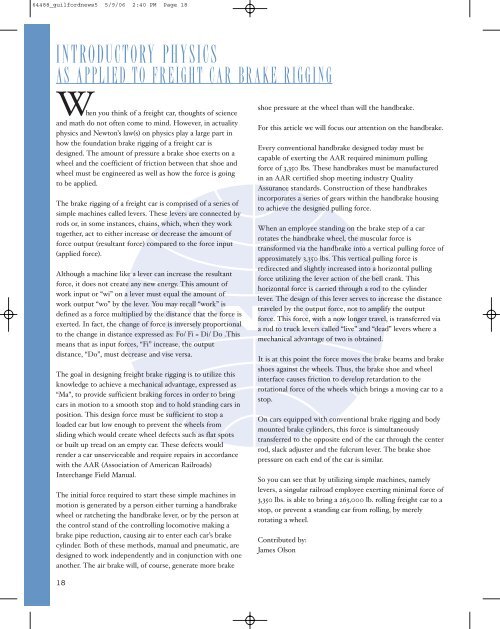Create successful ePaper yourself
Turn your PDF publications into a flip-book with our unique Google optimized e-Paper software.
64488_guilfordnews5 5/9/06 2:40 PM Page 18<br />
introductory physics<br />
as applied to freight car brake rigging<br />
When you think of a freight car, thoughts of science<br />
and math do not often come to mind. However, in actuality<br />
physics and Newton’s law(s) on physics play a large part in<br />
how the foundation brake rigging of a freight car is<br />
designed. The amount of pressure a brake shoe exerts on a<br />
wheel and the coefficient of friction between that shoe and<br />
wheel must be engineered as well as how the force is going<br />
to be applied.<br />
The brake rigging of a freight car is comprised of a series of<br />
simple machines called levers. These levers are connected by<br />
rods or, in some instances, chains, which, when they work<br />
together, act to either increase or decrease the amount of<br />
force output (resultant force) compared to the force input<br />
(applied force).<br />
Although a machine like a lever can increase the resultant<br />
force, it does not create any new energy. This amount of<br />
work input or “wi” on a lever must equal the amount of<br />
work output “wo” by the lever. You may recall “work” is<br />
defined as a force multiplied by the distance that the force is<br />
exerted. In fact, the change of force is inversely proportional<br />
to the change in distance expressed as: Fo/ Fi = Di/ Do .This<br />
means that as input forces, “Fi” increase, the output<br />
distance, “Do”, must decrease and vise versa.<br />
The goal in designing freight brake rigging is to utilize this<br />
knowledge to achieve a mechanical advantage, expressed as<br />
“Ma”, to provide sufficient braking forces in order to bring<br />
cars in motion to a smooth stop and to hold standing cars in<br />
position. This design force must be sufficient to stop a<br />
loaded car but low enough to prevent the wheels from<br />
sliding which would create wheel defects such as flat spots<br />
or built up tread on an empty car. These defects would<br />
render a car unserviceable and require repairs in accordance<br />
with the AAR (Association of <strong>Am</strong>erican Railroads)<br />
Interchange Field Manual.<br />
The initial force required to start these simple machines in<br />
motion is generated by a person either turning a handbrake<br />
wheel or ratcheting the handbrake lever, or by the person at<br />
the control stand of the controlling locomotive making a<br />
brake pipe reduction, causing air to enter each car’s brake<br />
cylinder. Both of these methods, manual and pneumatic, are<br />
designed to work independently and in conjunction with one<br />
another. The air brake will, of course, generate more brake<br />
18<br />
shoe pressure at the wheel than will the handbrake.<br />
For this article we will focus our attention on the handbrake.<br />
Every conventional handbrake designed today must be<br />
capable of exerting the AAR required minimum pulling<br />
force of 3,350 lbs. These handbrakes must be manufactured<br />
in an AAR certified shop meeting industry Quality<br />
Assurance standards. Construction of these handbrakes<br />
incorporates a series of gears within the handbrake housing<br />
to achieve the designed pulling force.<br />
When an employee standing on the brake step of a car<br />
rotates the handbrake wheel, the muscular force is<br />
transformed via the handbrake into a vertical pulling force of<br />
approximately 3,350 lbs. This vertical pulling force is<br />
redirected and slightly increased into a horizontal pulling<br />
force utilizing the lever action of the bell crank. This<br />
horizontal force is carried through a rod to the cylinder<br />
lever. The design of this lever serves to increase the distance<br />
traveled by the output force, not to amplify the output<br />
force. This force, with a now longer travel, is transferred via<br />
a rod to truck levers called “live” and “dead” levers where a<br />
mechanical advantage of two is obtained.<br />
It is at this point the force moves the brake beams and brake<br />
shoes against the wheels. Thus, the brake shoe and wheel<br />
interface causes friction to develop retardation to the<br />
rotational force of the wheels which brings a moving car to a<br />
stop.<br />
On cars equipped with conventional brake rigging and body<br />
mounted brake cylinders, this force is simultaneously<br />
transferred to the opposite end of the car through the center<br />
rod, slack adjuster and the fulcrum lever. The brake shoe<br />
pressure on each end of the car is similar.<br />
So you can see that by utilizing simple machines, namely<br />
levers, a singular railroad employee exerting minimal force of<br />
3,350 lbs. is able to bring a 263,000 lb. rolling freight car to a<br />
stop, or prevent a standing car from rolling, by merely<br />
rotating a wheel.<br />
Contributed by:<br />
James Olson



